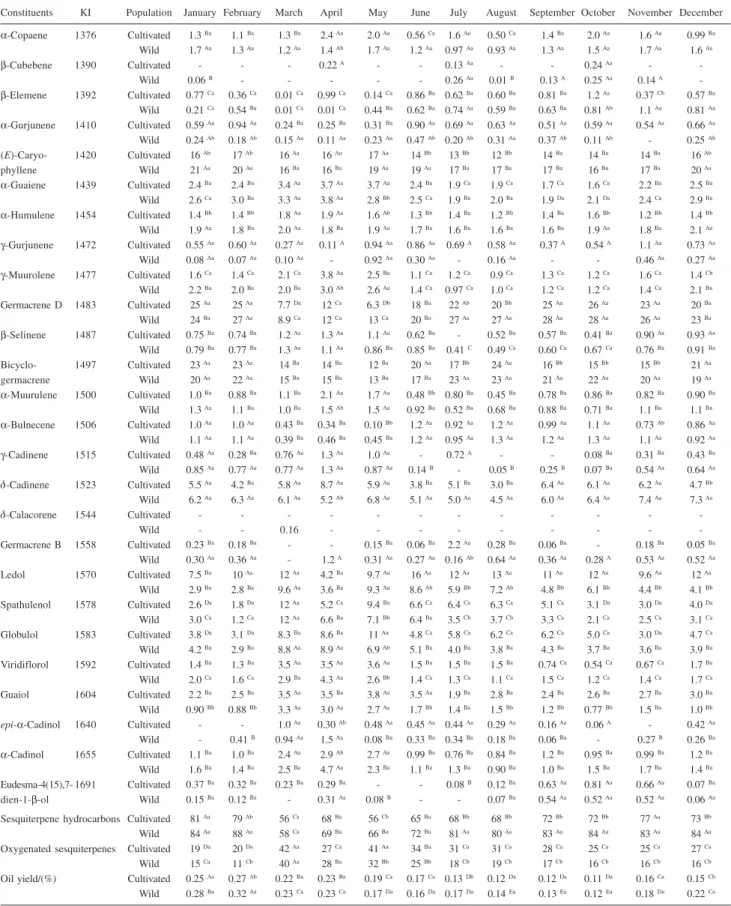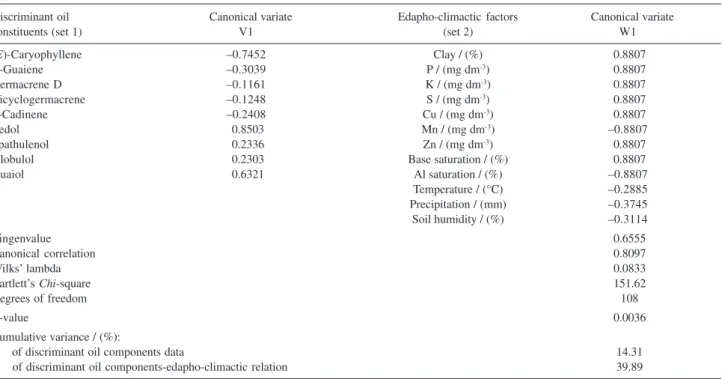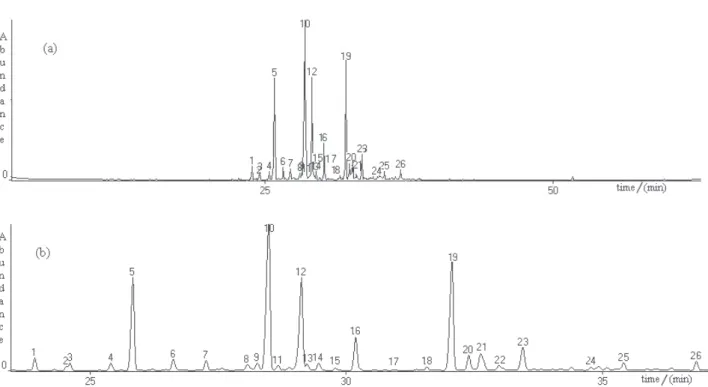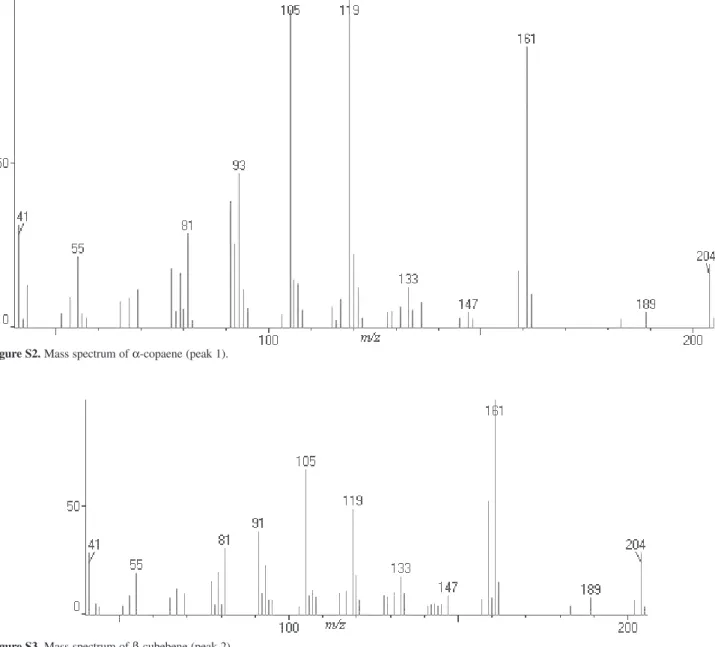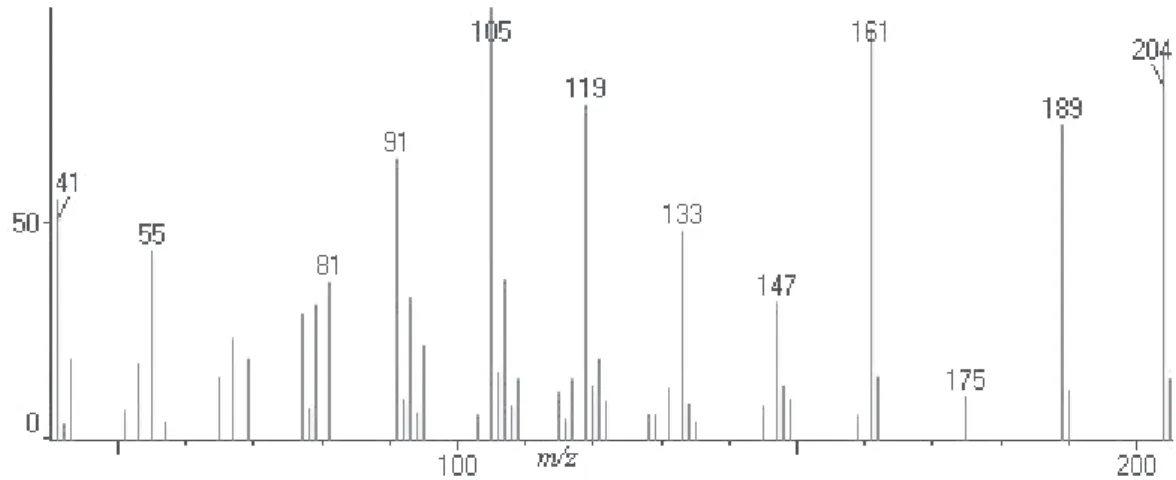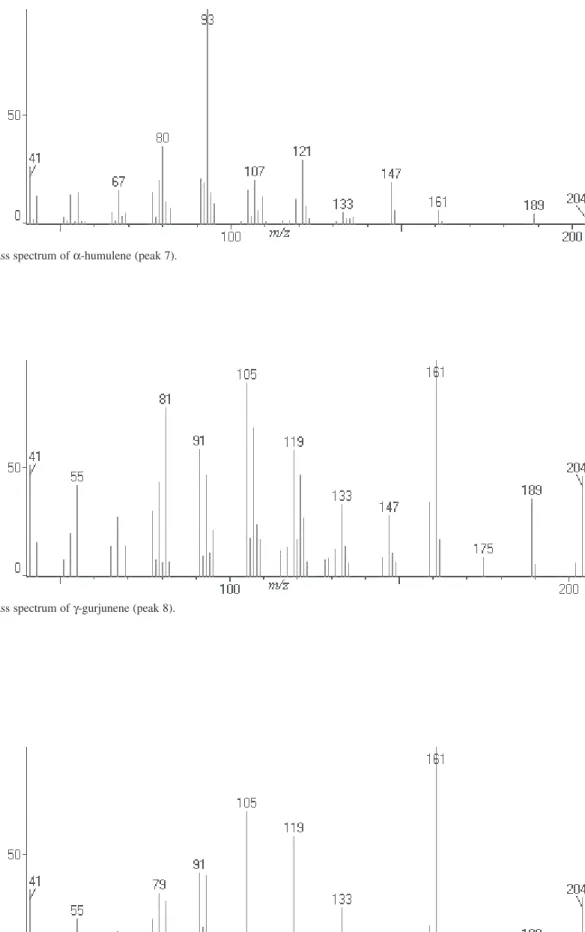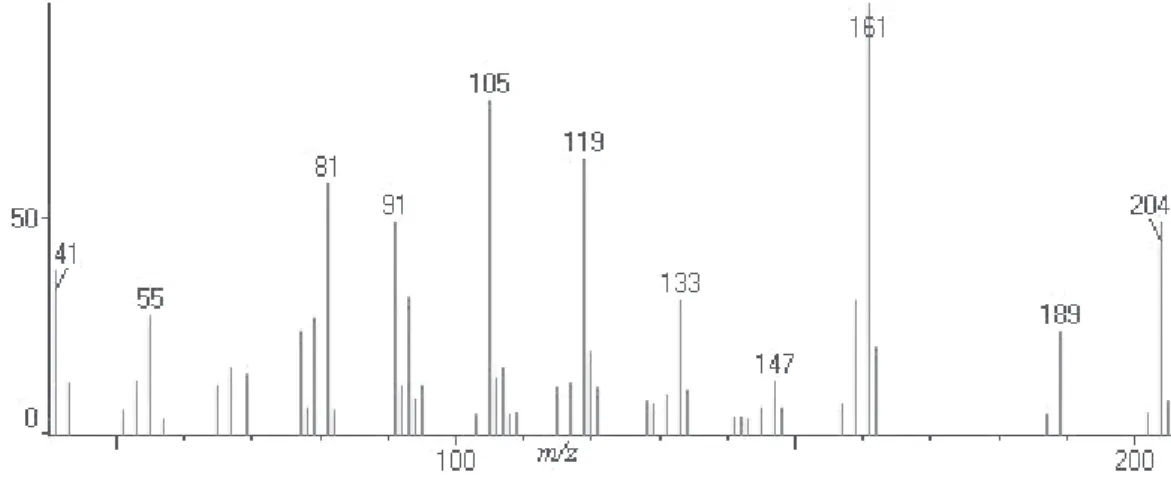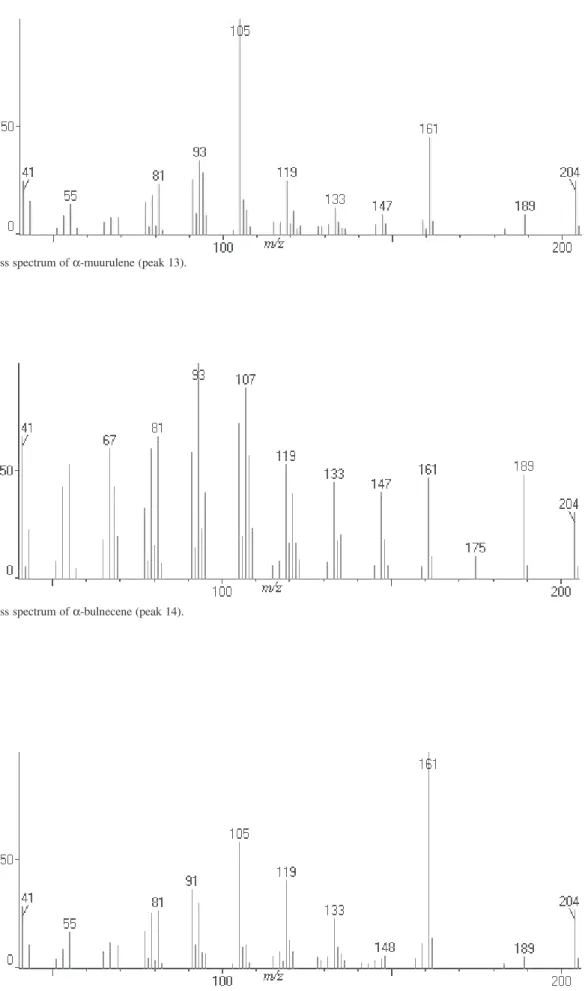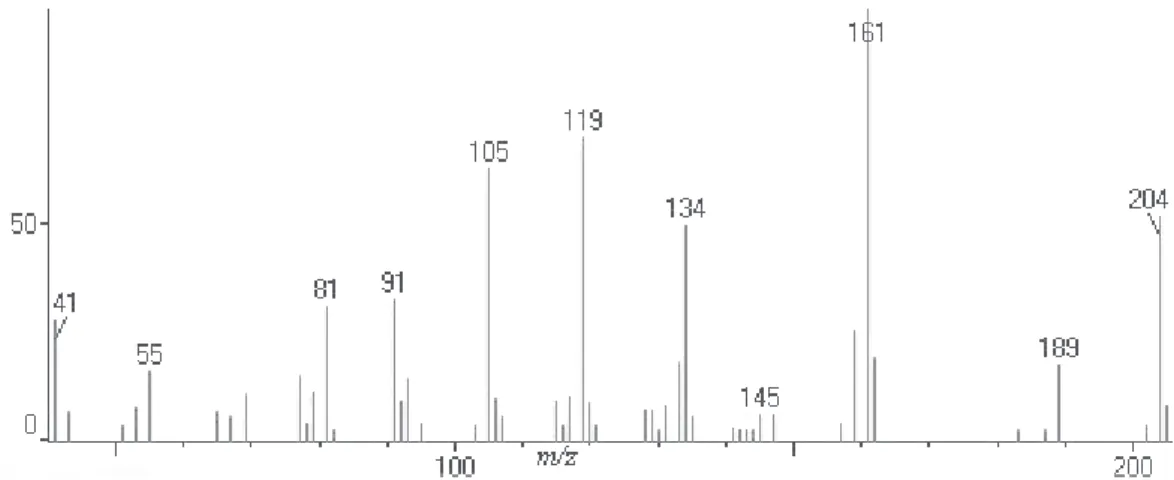J. Braz. Chem. Soc., Vol. 18, No. 5, 990-997, 2007. Printed in Brazil - ©2007 Sociedade Brasileira de Química 0103 - 5053 $6.00+0.00
Article
*e-mail: pedro@quimica.ufg.br
Seasonal Variability in the Essential Oils of Wild and Cultivated Baccharis trimera
Fabiano G. Silva,a Carolina B. A. Oliveira,b José Eduardo B. P. Pinto,c Vivian E. Nascimento,c
Suzana C. Santos,b José C. Seraphind and Pedro H. Ferri*,b
a
Laboratório de Cultura de Tecidos, Centro Federal de Educação Tecnológica de Rio Verde, CP 66, 75900-000 Rio Verde-GO, Brazil
b
Laboratório de Bioatividade Molecular, Instituto de Química, Universidade Federal de Goiás, CP 131, 74001-970 Goiânia-GO, Brazil
c
Laboratório de Cultura de Tecidos e Plantas Medicinais, Departamento de Agricultura, Universidade Federal de Lavras, CP 37, 37200-000 Lavras-MG, Brazil
d
Núcleo de Estatística Aplicada, Instituto de Matemática e Estatística, Universidade Federal de Goiás, CP 131, 74001-970 Goiânia-GO, Brazil
A variação sazonal na composição química do óleo essencial em populações de Baccharis trimera natural e cultivada indicou a presença de três grupos de óleos em relação à origem e à fase de desenvolvimento das amostras. O primeiro incluiu amostras floridas, silvestres ou cultivadas, no período entre março-maio, contendo altas percentagens de globulol e espatulenol. No grupo II, com amostras silvestres coletadas entre junho-fevereiro, os constituintes majoritários foram o germacreno D e o (E)-cariofileno, enquanto que o grupo III incluiu amostras cultivadas entre junho-fevereiro e contendo um alto conteúdo de ledol. A análise por correlação canônica indicou que (E)-cariofileno, Mn, saturação por Al e precipitação foram fortemente correlacionados às amostras silvestres (grupo II), enquanto ledol e guaiol correlacionaram-se ao balanço químico do solo (P, K, S, Cu, Zn e saturação por bases) nas amostras cultivadas (grupo III). Ambos os óleos essenciais tem predominantemente hidrocarbonetos, embora em dois meses o conteúdo em sesquiterpenos oxigenados seja superior a 40% para ambas as amostras. As variações observadas podem estar relacionadas ao ambiente.
The seasonal variations in the chemical composition of the essential oil of wild and cultivated
Baccharis trimera populations indicated the presence of three clusters of oils regarding population and phenophase. The first included flowering, wild, and cultivated samples from a period of March-May, with high percentages of globulol and spathulenol. In cluster II, with wild samples collected from June-February, the major constituents were germacrene D and (E)-caryophyllene, while cluster III included cultivated samples from June-February containing a high content of ledol. The canonical correlation analysis revealed that (E)-caryophyllene, Mn, Al saturation, and precipitation were quite strongly related to wild samples (cluster II), whereas ledol and guaiol were related to chemical balance in soils (P, K, S, Cu, Zn, and base saturation) of cultivated samples (cluster III). Both essential oils have predominantly hydrocarbon compositions, although for a couple of months the oxygenated sesquiterpene content is over 40% for both samples. The observed chemovariation might be environmentally determined.
Keywords: Baccharis trimera, Asteraceae, essential oil, chemical variability, seasonal variation
Introduction
Baccharis species (Asteraceae) are widespread in South America and are known as ‘carqueja’. Several
species are used in traditional medicine or are reputed as toxic to cattle and sheep.1 Medicinal teas prepared from
popular uses in Brazil show that B. trimera is employed in the treatment of malaria, sore throat and tonsillitis, angines, anaemia, urinary inflammation and leprosy.2-4
Liver-protective properties, gastrointestinal action, potential antidiabetic activity, and anti-arthritic effects have been validated,5,6 and the anti-ophidian, relaxant,
antimutagenic, antimicrobial, and antiprotozoal activities have also been reported.7,8
Chemical studies revealed the presence of clerodane-type diterpenes, saponins and their glycosides, and several flavonoids in this species.5,7 Carqueja oil, a commercial
fragrance cited as a reminiscent of rosewood,9 is
stem-distilled from its aerial parts, with the unusual monoterpene alcohol carquejol and its acetyl ester as major components.10-17 The commercial value of this oil which
is produced in Brazil has been associated with the high content of carquejyl acetate which has showed variations of 30% to 69.2%.3,9,14 Carquejyl acetate was found in B.
trimera which was collected in different places of southern Brazil and Argentina, and has been regarded as a chemomarker of this species,17 although it has been absent
in collected samples in Paraná and Santa Catarina states, South Brazil,18 and identified in other species of the same
genera.15
Despite the great demand of B. trimera in the phytotherapeutic industry,18,19 as well as the demand for
fragrance - B. trimera’s essential oil is cited as one of the ten most consumed oils by cosmetic industries in Brazil20
-the variability in essential oil of wild and cultivated plants has not yet been obtained.21 In fact, natural populations
have been excessively exploited and their natural habitats have been replaced by commercial crops. As a result, the amount of this wild plant has decreased.21
As part of our ongoing work on the characterization of essential oils of medicinal aromatic plants growing wild in the Brazilian Cerrado,22 we now report on the results
obtained for the essential oil composition and seasonal variability of B. trimera that was collected from wild and cultivated populations during a 1-year period. For this purpose, essential oils from aerial parts of representative population samples of each origin were analyzed by GC-MS. In order to study chemical variability, chemical constituents were submitted to Principal Component, chemometric Cluster, and Canonical Discriminant analysis in order to detect the pattern distribution of samples and to identify which constituents can distinguish between these groups of individuals. In addition, environmental factors affecting essential oil variability were studied through the application of a Canonical Correlation analysis between the oil component data set and the edaphic-climactic data matrix with 26 variables for each sampling.
Results and Discussion
B. trimera essential oils were obtained from wild and from cultivated populations. The annual mean yield of oils from wild samples was higher than that of the cultivated plants. Previous work has indicated that organic fertilizer and shade showed no significant effects on the essential oil yield,21,23 but radiation
increased the content of essential oils in cultivated carqueja.24 The seasonal dynamics of essential oil yield
in both populations were similar to those of other Cerrado species, which revealed lower values during the dry winter.25 In total, 26 compounds were identified,
accounting for 96-100% of the volatile constituents (Table 1). Both essential oils have predominantly sesquiterpene hydrocarbon compositions, although for a couple of months the oxygenated sesquiterpene content is over 40% for both samples. Essential oils from the Baccharis species have showed that, although the main constituent may vary, sesquiterpenes are usually the dominant class.26 Furthermore, important
differences in the amounts of the major constituents were found, mainly of germacrene D (6.3-28%) which had the highest percentage in September-November (both populations); ledol (2.5-16%) showed a high variation in the wild population, while cultivated samples revealed higher amounts, regardless of the months; and bicyclogermacrene (12-24%) had the highest contents between July-February in the wild population, and in December-February in cultivated ones.
The results obtained from PCA and nearest neighbour complete linkage cluster analysis using Ward’s technique revealed the existence of a high chemical variability within the essential oils of B. trimera.27 Figure 1 shows the relative
position of the individuals in the discriminant space in relation to an axial system that was originated in the PCA. First PC accounts for ca. 47% of the total variance and separates (p < 0.0001) the oxygenated sesquiterpenes of flowering sampling (March-May) from vegetative sampling, regardless of the populations, while the Second PC distinguishes (p < 0.0001) the wild sampling from that of the cultivated population in the June-April period. Therefore, three types of essential oils were found: cluster I (wild and cultivated samples harvested in March-May), being characterised by a high percentage (p < 0.0001) of globulol (8.9 ± 3.4%), spathulenol (8.7 ± 3.1%), α-guaieno (3.4 ± 0.4%), viridiflorol (3.4 ± 0.9%), guaiol (3.1 ± 0.8%), and δ-cadinene (6.6 ± 1.9%) (p < 0.007); cluster II (wild samples harvested between June-February) with (p <
992 Seasonal Variability in the Essential Oils of Wild and Cultivated Baccharis trimera J. Braz. Chem. Soc.
Table 1. Mean valuesa of volatile components from populations of cultivated or nature-collected B. trimera during the year
Constituents KI Population January February March April May June July August September October November December
α-Copaene 1376 Cultivated 1.3 Ba 1.1 Ba 1.3 Ba 2.4 Aa 2.0 Aa 0.56 Ca 1.6 Aa 0.50 Ca 1.4 Ba 2.0 Aa 1.6 Aa 0.99 Ba
Wild 1.7 Aa 1.3 Aa 1.2 Aa 1.4 Ab 1.7 Aa 1.2 Aa 0.97 Aa 0.93 Aa 1.3 Aa 1.5 Aa 1.7 Aa 1.6 Aa
β-Cubebene 1390 Cultivated - - - 0.22 A - - 0.13 Aa - - 0.24 Aa -
-Wild 0.06 B - - - - - 0.26 Aa 0.01 B 0.13 A 0.25 Aa 0.14 A
-β-Elemene 1392 Cultivated 0.77 Ca 0.36 Ca 0.01 Ca 0.99 Ca 0.14 Ca 0.86 Ba 0.62 Ba 0.60 Ba 0.81 Ba 1.2 Aa 0.37 Cb 0.57 Ba
Wild 0.21 Ca 0.54 Ba 0.01 Ca 0.01 Ca 0.44 Ba 0.62 Ba 0.74 Aa 0.59 Ba 0.63 Ba 0.81 Ab 1.1 Aa 0.81 Aa
α-Gurjunene 1410 Cultivated 0.59 Aa 0.94 Aa 0.24 Ba 0.25 Ba 0.31 Ba 0.90 Aa 0.69 Aa 0.63 Aa 0.51 Aa 0.59 Aa 0.54 Aa 0.66 Aa
Wild 0.24 Ab 0.18 Ab 0.15 Aa 0.11 Aa 0.23 Aa 0.47 Ab 0.20 Ab 0.31 Aa 0.37 Ab 0.11 Ab - 0.25 Ab
(E)-Caryo- 1420 Cultivated 16 Ab 17 Ab 16 Aa 16 Aa 17 Aa 14 Bb 13 Bb 12 Bb 14 Ba 14 Ba 14 Ba 16 Ab
phyllene Wild 21 Aa 20 Aa 16 Ba 16 Ba 19 Aa 19 Aa 17 Ba 17 Ba 17 Ba 16 Ba 17 Ba 20 Aa
α-Guaiene 1439 Cultivated 2.4 Ba 2.4 Ba 3.4 Aa 3.7 Aa 3.7 Aa 2.4 Ba 1.9 Ca 1.9 Ca 1.7 Ca 1.6 Ca 2.2 Ba 2.5 Ba
Wild 2.6 Ca 3.0 Ba 3.3 Aa 3.8 Aa 2.8 Bb 2.5 Ca 1.9 Ba 2.0 Ba 1.9 Da 2.1 Da 2.4 Ca 2.9 Ba
α-Humulene 1454 Cultivated 1.4 Bb 1.4 Bb 1.8 Aa 1.9 Aa 1.6 Ab 1.3 Bb 1.4 Ba 1.2 Bb 1.4 Ba 1.6 Bb 1.2 Bb 1.4 Bb
Wild 1.9 Aa 1.8 Ba 2.0 Aa 1.8 Ba 1.9 Aa 1.7 Ba 1.6 Ba 1.6 Ba 1.6 Ba 1.9 Aa 1.8 Ba 2.1 Aa
γ-Gurjunene 1472 Cultivated 0.55 Aa 0.60 Aa 0.27 Aa 0.11 A 0.94 Aa 0.86 Aa 0.69 A 0.58 Aa 0.37 A 0.54 A 1.1 Aa 0.73 Aa
Wild 0.08 Aa 0.07 Aa 0.10 Aa - 0.92 Aa 0.30 Aa - 0.16 Aa - - 0.46 Aa 0.27 Aa
γ-Muurolene 1477 Cultivated 1.6 Ca 1.4 Ca 2.1 Ca 3.8 Aa 2.5 Ba 1.1 Ca 1.2 Ca 0.9 Ca 1.3 Ca 1.2 Ca 1.6 Ca 1.4 Cb
Wild 2.2 Ba 2.0 Ba 2.0 Ba 3.0 Ab 2.6 Aa 1.4 Ca 0.97 Ca 1.0 Ca 1.2 Ca 1.2 Ca 1.4 Ca 2.1 Ba
Germacrene D 1483 Cultivated 25 Aa 25 Aa 7.7 Da 12 Ca 6.3 Db 18 Ba 22 Ab 20 Bb 25 Aa 26 Aa 23 Aa 20 Ba
Wild 24 Ba 27 Aa 8.9 Ca 12 Ca 13 Ca 20 Ba 27 Aa 27 Aa 28 Aa 28 Aa 26 Aa 23 Ba
β-Selinene 1487 Cultivated 0.75 Ba 0.74 Ba 1.2 Aa 1.3 Aa 1.1 Aa 0.62 Ba - 0.52 Ba 0.57 Ba 0.41 Ba 0.90 Aa 0.93 Aa
Wild 0.79 Ba 0.77 Ba 1.3 Aa 1.1 Aa 0.86 Ba 0.85 Ba 0.41 C 0.49 Ca 0.60 Ca 0.67 Ca 0.76 Ba 0.91 Ba
Bicyclo- 1497 Cultivated 23 Aa 23 Aa 14 Ba 14 Ba 12 Ba 20 Aa 17 Bb 24 Aa 16 Bb 15 Bb 15 Bb 21 Aa
germacrene Wild 20 Aa 22 Aa 15 Ba 15 Ba 13 Ba 17 Ba 23 Aa 23 Aa 21 Aa 22 Aa 20 Aa 19 Aa
α-Muurulene 1500 Cultivated 1.0 Ba 0.88 Ba 1.1 Ba 2.1 Aa 1.7 Aa 0.48 Bb 0.80 Ba 0.45 Ba 0.78 Ba 0.86 Ba 0.82 Ba 0.90 Ba
Wild 1.3 Aa 1.1 Ba 1.0 Ba 1.5 Ab 1.5 Aa 0.92 Ba 0.52 Ba 0.68 Ba 0.88 Ba 0.71 Ba 1.1 Ba 1.1 Ba
α-Bulnecene 1506 Cultivated 1.0 Aa 1.0 Aa 0.43 Ba 0.34 Ba 0.10 Bb 1.2 Aa 0.92 Aa 1.2 Aa 0.99 Aa 1.1 Aa 0.73 Ab 0.86 Aa
Wild 1.1 Aa 1.1 Aa 0.39 Ba 0.46 Ba 0.45 Ba 1.2 Aa 0.95 Aa 1.3 Aa 1.2 Aa 1.3 Aa 1.1 Aa 0.92 Aa
γ-Cadinene 1515 Cultivated 0.48 Aa 0.28 Ba 0.76 Aa 1.3 Aa 1.0 Aa - 0.72 A - - 0.08 Ba 0.31 Ba 0.43 Ba
Wild 0.85 Aa 0.77 Aa 0.77 Aa 1.3 Aa 0.87 Aa 0.14 B - 0.05 B 0.25 B 0.07 Ba 0.54 Aa 0.64 Aa
δ-Cadinene 1523 Cultivated 5.5 Aa 4.2 Ba 5.8 Aa 8.7 Aa 5.9 Aa 3.8 Ba 5.1 Ba 3.0 Ba 6.4 Aa 6.1 Aa 6.2 Aa 4.7 Bb
Wild 6.2 Aa 6.3 Aa 6.1 Aa 5.2 Ab 6.8 Aa 5.1 Aa 5.0 Aa 4.5 Aa 6.0 Aa 6.4 Aa 7.4 Aa 7.3 Aa
δ-Calacorene 1544 Cultivated - - -
-Wild - - 0.16 - - -
-Germacrene B 1558 Cultivated 0.23 Ba 0.18 Ba - - 0.15 Ba 0.06 Ba 2.2 Aa 0.28 Ba 0.06 Ba - 0.18 Ba 0.05 Ba
Wild 0.30 Aa 0.36 Aa - 1.2 A 0.31 Aa 0.27 Aa 0.16 Ab 0.64 Aa 0.36 Aa 0.28 A 0.53 Aa 0.52 Aa
Ledol 1570 Cultivated 7.5 Ba 10 Aa 12 Aa 4.2 Ba 9.7 Aa 16 Aa 12 Aa 13 Aa 11 Aa 12 Aa 9.6 Aa 12 Aa
Wild 2.9 Ba 2.8 Ba 9.6 Aa 3.6 Ba 9.3 Aa 8.6 Ab 5.9 Bb 7.2 Ab 4.8 Bb 6.1 Bb 4.4 Bb 4.1 Bb
Spathulenol 1578 Cultivated 2.6 Da 1.8 Da 12 Aa 5.2 Ca 9.4 Ba 6.6 Ca 6.4 Ca 6.3 Ca 5.1 Ca 3.1 Da 3.0 Da 4.0 Da
Wild 3.0 Ca 1.2 Ca 12 Aa 6.6 Ba 7.1 Bb 6.4 Ba 3.5 Cb 3.7 Cb 3.3 Ca 2.1 Ca 2.5 Ca 3.1 Ca
Globulol 1583 Cultivated 3.8 Da 3.1 Da 8.3 Ba 8.6 Ba 11 Aa 4.8 Ca 5.8 Ca 6.2 Ca 6.2 Ca 5.0 Ca 3.0 Da 4.7 Ca
Wild 4.2 Ba 2.9 Ba 8.8 Aa 8.9 Aa 6.9 Ab 5.1 Ba 4.0 Ba 3.8 Ba 4.3 Ba 3.7 Ba 3.6 Ba 3.9 Ba
Viridiflorol 1592 Cultivated 1.4 Ba 1.3 Ba 3.5 Aa 3.5 Aa 3.6 Aa 1.5 Ba 1.5 Ba 1.5 Ba 0.74 Ca 0.54 Ca 0.67 Ca 1.7 Ba
Wild 2.0 Ca 1.6 Ca 2.9 Ba 4.3 Aa 2.6 Bb 1.4 Ca 1.3 Ca 1.1 Ca 1.5 Ca 1.2 Ca 1.4 Ca 1.7 Ca
Guaiol 1604 Cultivated 2.2 Ba 2.5 Ba 3.5 Aa 3.5 Ba 3.8 Aa 3.5 Aa 1.9 Ba 2.8 Ba 2.4 Ba 2.6 Ba 2.7 Ba 3.0 Ba
Wild 0.90 Bb 0.88 Bb 3.3 Aa 3.0 Aa 2.7 Aa 1.7 Bb 1.4 Ba 1.5 Bb 1.2 Bb 0.77 Bb 1.5 Ba 1.0 Bb
epi-α-Cadinol 1640 Cultivated - - 1.0 Aa 0.30 Ab 0.48 Aa 0.45 Aa 0.44 Aa 0.29 Aa 0.16 Aa 0.06 A - 0.42 Aa
Wild - 0.41 B 0.94 Aa 1.5 Aa 0.08 Ba 0.33 Ba 0.34 Ba 0.18 Ba 0.06 Ba - 0.27 B 0.26 Ba
α-Cadinol 1655 Cultivated 1.1 Ba 1.0 Ba 2.4 Aa 2.9 Ab 2.7 Aa 0.99 Ba 0.76 Ba 0.84 Ba 1.2 Ba 0.95 Ba 0.99 Ba 1.2 Ba
Wild 1.6 Ba 1.4 Ba 2.5 Ba 4.7 Aa 2.3 Ba 1.1 Ba 1.3 Ba 0.90 Ba 1.0 Ba 1.5 Ba 1.7 Ba 1.4 Ba
Eudesma-4(15),7- 1691 Cultivated 0.37 Ba 0.32 Ba 0.23 Ba 0.29 Ba - - 0.08 B 0.12 Ba 0.63 Aa 0.81 Aa 0.66 Aa 0.07 Ba
dien-1-β-ol Wild 0.15 Ba 0.12 Ba - 0.31 Aa 0.08 B - - 0.07 Ba 0.54 Aa 0.52 Aa 0.52 Aa 0.06 Aa
Sesquiterpene hydrocarbons Cultivated 81 Aa 79 Ab 56 Ca 68 Ba 56 Cb 65 Ba 68 Bb 68 Bb 72 Bb 72 Bb 77 Aa 73 Bb
Wild 84 Aa 88 Aa 58 Ca 69 Ba 66 Ba 72 Ba 81 Aa 80 Aa 83 Aa 84 Aa 83 Aa 84 Aa
Oxygenated sesquiterpenes Cultivated 19 Da 20 Da 42 Aa 27 Ca 41 Aa 34 Ba 31 Ca 31 Ca 28 Ca 25 Ca 25 Ca 27 Ca
Wild 15 Ca 11 Cb 40 Aa 28 Ba 32 Bb 25 Bb 18 Cb 19 Cb 17 Cb 16 Cb 16 Cb 16 Cb
Oil yield/(%) Cultivated 0.25 Aa 0.27 Ab 0.22 Ba 0.23 Ba 0.19 Ca 0.17 Ca 0.13 Db 0.12 Da 0.12 Da 0.11 Da 0.16 Ca 0.15 Cb
Wild 0.28 Ba 0.32 Aa 0.23 Ca 0.23 Ca 0.17 Da 0.16 Da 0.17 Da 0.14 Ea 0.13 Ea 0.12 Ea 0.18 Da 0.22 Ca
a Percentage data. Means followed by the same capital letter in the rows and same small letter in the columns did not share significant differences at 5%
(19 ± 2%) as principal constituents; and cluster III (cultivated samples harvested in the June-February period) containing a high amount of ledol (12 ± 3%) (p < 0.0001).
The canonical discriminant analysis (CDA) confir-med this clustering as a priori groupings and a two-dimensional axial system that originated in the CDA distinguished the different types of essential oils based on the contents of globulol, germacrene D and ledol as predictor variables (Figure 2). The first discriminant function (F1) accounts for ca. 90% of the total variability and separates the samples in flowering stage (p <
0.0001), regardless of the population, due to the high content of globulol. On the other hand, the second discriminant function (F2) distinguishes the harvested samples according to the wild or cultivated population (p < 0.0003), as a result of the high contents of germacrene D and ledol, respectively. In addition, when using the two discriminant functions it is possible to predict accurately ca. 96% well classification in the original clusters (only one misclassification) by a cross-validation approach. This approach involves taking a slightly reduced number of samples from the parent data set, estimating parameters from each of these modified data sets and then calculating the precision of the predictions for the samples previously removed by the resulting models.28 The only observed misclassification
was the cultivated sample harvested in January (Figure 2), which was classified as belonging to the wild population. Such misclassification could be caused by lower levels of ledol during January (a characteristic of wild samples).
All these findings may be correlated with factors other than genetic determination as biotic pressures which could modulate the volatiles of cluster I (flowering phase) from clusters II and III (vegetative phase), the former being influenced by pollinators and the latter by pathogens and herbivores or because of differences in environmental conditions.29 In fact, the canonical correlation analysis
(Table 2) between populations and soils revealed that ledol and guaiol present a strong relationship with chemical balance in soils (P, K, S, Cu, Zn, and base saturation) and are related to the cultivated samples collected in the June-February period (cluster III). In addition, (E )-caryophyllene from the first set and Mn, Al saturation, soil humidity, and precipitation from the second set load fairly strongly onto the first canonical variable, which is related to the wild samples collected in the June-February period (cluster II).
Unlike previous studies which used plants that were collected in different places of southern Brazil and Argentina,10-17 where carquejol reached 0-9% and
carquejyl acetate 12.2-69.2%, our results did not reveal any of these chemicals. By contrast, germacrene D (21 ± 7%), bicyclogermacrene (19 ± 4%), (E)-caryophyllene (17 ± 3%), ledol (8.3 ± 4.0%), δ-cadinene (5.8 ± 1.6%), globulol (5.4 ± 2.5%), and spathulenol (5.0 ± 3.1%) were always present as major compounds in our samples, whereas in previous studies some of these chemicals were obtained as minor constituents or were only reported in trace amounts.11-13,16,17 Some studies report high contents
of ledol (9.93 ± 7.34%),16,17 whereas other researches did
not find these volatiles at all.10,14,15 The lack of carquejol
and carquejyl acetate was also reported in samples Figure 1. Principal Component scatterplot of B. trimera samples
col-lected from wild and cultivated populations to which cluster it belongs: I (z), II () and III ().
994 Seasonal Variability in the Essential Oils of Wild and Cultivated Baccharis trimera J. Braz. Chem. Soc.
collected in Santa Catarina and Paraná states in South Brazil, in which essential oils were obtained by different methods, such as hydrodistillation by Clevenger apparatus, supercritical fluid extraction, and hexane extract.18
To judge from the current available data, a trend of oxidised monoterpenes seems to accompany the transition of sampling sites from the Brazilian Cerrado (present study) to sites in southern Brazil and Argentina. The same pattern is found when the climate is considered. Along this direction, a gradual change from the hot and dry to the cold and humid Austral Continental type occurs,30
suggesting that edapho-climactic variations may explain polymorphism in essential oils. A similar oxidative gradient was described for the emmotin sesquiterpenoids in South America,31 and for monoterpenes and
sesquiterpenes in Hyptis suaveolens (Lamiaceae), but with an increase in the oxidised level from the Brazilian Cerrado to the Amazonian region.32
Thus, the variation pattern in the essential oil may reflect selective pressures in the different ecological and geographical environments (ecotypes) or indicate that the observed chemical variations could be due to the existence of chemotypes for B. trimera, which have not yet been described for Baccharis species. Therefore, caution is necessary in the use of carquejyl acetate as a chemomarker of B. trimera for this compound could be in part environmentally determined. In spite of the correlation obtained for the oil composition with edapho-climactic
factors and the variance explained by the environmental data set (Table 2), there is an outstanding percentage of variability in oil composition that should be the subject of subsequent genetic studies.
Experimental
Plant material
B. trimera samples were collected between March 2003 and February 2004 in Lavras city (S 21° 13’; W 44° 57’; 919 m), Minas Gerais State, Brazil, and were identified by Prof. Dr. Manoel Losada Gavilanes of Departamento de Biologia, Universidade Federal de Lavras (UFLA), Minas Gerais State, Brazil. Samples from their natural habitat were collected on a monthly basis, and plantlets obtained by cutting propagation were cultivated in an experimental field at the Setor de Horticultura of Universidade Federal de Lavras (UFLA),21
Minas Gerais State, Brazil. The natural habitat was located at 20 km from the cultivated samples. Field trial was performed in the form of a randomised block with three replications. In the March-May period, the plants included both leaves and flowers. Voucher specimen is deposited in UFLA’s Herbarium (code number 169933).
In order to assess the chemical composition of oils, the aerial parts of 40100 randomised individual plants -representing the local population as homogeneous samples Table 2. Canonical correlation structure (loadings) of the oil components and edapho-climactic factors with their canonical variates
Discriminant oil Canonical variate Edapho-climactic factors Canonical variate
constituents (set 1) V1 (set 2) W1
(E)-Caryophyllene –0.7452 Clay / (%) 0.8807
α-Guaiene –0.3039 P / (mg dm-3) 0.8807
Germacrene D –0.1161 K / (mg dm-3) 0.8807
Bicyclogermacrene –0.1248 S / (mg dm-3) 0.8807
δ-Cadinene –0.2408 Cu / (mg dm-3) 0.8807
Ledol 0.8503 Mn / (mg dm-3) –0.8807
Spathulenol 0.2336 Zn / (mg dm-3) 0.8807
Globulol 0.2303 Base saturation / (%) 0.8807
Guaiol 0.6321 Al saturation / (%) –0.8807
Temperature / (°C) –0.2885
Precipitation / (mm) –0.3745
Soil humidity / (%) –0.3114
Eingenvalue 0.6555
Canonical correlation 0.8097
Wilks’ lambda 0.0833
Bartlett’s Chi-square 151.62
Degrees of freedom 108
P-value 0.0036
Cumulative variance / (%):
of discriminant oil components data 14.31
- were simultaneously collected from cultivated plants and from their original natural habitat and dried by dehumidification in Arsec 160 apparatus for 3 days at 35 °C until constant weight. After having been chopped, the dried phytomass (50 g) was submitted to hydro-distillation (1 h) using a modified Clevenger-type apparatus. At the end of each distillation, oils were collected by extracting the aqueous solution with CH2Cl2 (3 × 90 mL), drying the dichloromethane layer with anhydrous MgSO4, and removing the solvent in a rotavapor under reduced pressure at 40 °C. The oils were transferred to glass flasks and kept at a temperature of –18 °C. Oil yields (%) were based on the dried weight of plant samples. All experiments were conducted in triplicates.
Soil analyses
Five-soil samples were collected at a 20 cm depth in each locality in March 2003. These samples were then pooled together to form one composite sample and subsequently air-dried, thoroughly mixed, and sieved (2 mm). The portion which was finer than 2 mm was kept for physical and chemical analysis.33 The pH was
determined in a 1:1 soil-water volume ratio. Ca, Mg and Al were extracted with 1mol L-1 KCl, and P, K, Zn, Cu,
Fe, Mn were extracted with Mehlich’s solution. Organic matter, cationic exchange capacity (CEC), potential acidity (H+Al), base saturation, Al saturation, and soil texture were determined by applying the usual methods.33
Soil humidity (at a 20 cm depth) was determined monthly by the gravimetric method, and was conducted in triplicates. Mean monthly values of temperature (minimal, average and maximal), precipitation, and humidity were obtained from UFLA’s climatological station. Environmental factor data originating from both climatological records and soil analysis were ordered in an edapho-climactic matrix with 26 variables for each sampling site. In both data sets, essential oil components and edapho-climactic characteristics, a canonical correlation procedure was applied. This method finds the linear combinations of the variables which have the highest correlation between them.
In geographical terms, the natural habitat presents a loam texture, while the cultivated field has a sandy loam. Site elevation, mean annual rainfall, mean temperature, and mean annual relative humidity are, however, similar.
Chemical analysis
Oil sample analyses were performed on a GC-MS Shimadzu QP5050A instrument under the following
conditions: a CBP-5 (Shimadzu) fused silica capillary column (30 m × 0.25 mm i.d., 0.25 µm film thickness) connected to a quadrupole detector operating in the EI mode at 70 eV with a scan mass range of 40-400 m/z at a sampling rate of 1.0 scan s-1; carrier gas: He (1 mL min-1);
injector and interface temperatures of 220 °C and 240 °C, respectively, with a split ratio of 1:20. The injection volume was 0.2 µL (20% in CH2Cl2) and the oven temperature was raised from 60 °C to 246 °C, with an increase of 3 °C min-1, then 10 °C min-1 to 270 °C, holding
the final temperature for 5 min. Individual components were identified by comparing their Kovats retention indexes (RI),34 made by a co-injection with a C
8-C32
n-alkanes series,35 mass spectra with those of the literature,
and a computerised MS-data base using NIST libraries.34,36
Chemical variability
Principal Component Analysis (PCA) was applied in order to examine the interrelationships between populations and their essential oil constituents using Système Portable d’Analyse des Données Numériques-SPAD.N software package, version 2.5, Centre International de Statistique et d’Informatique Appliquées, France (1994). Cluster analysis was also applied to the study of similarity of samples on the basis of essential oil constituent distribution. Nearest neighbour complete linkage technique by Benzécri algorithm was used as an index of similarity, and hierarchical clustering was performed according to the Ward´s variance minimizing method.27,37
Canonical discriminant analysis using SAS CANDISC procedure (Statistical Analysis System, SAS Institute Inc., Cary, NC, 1996) was used to differentiate between populations and clusters on the basis of oil composition. The predictive ability of canonical discriminant functions was evaluated by cross-validation leaving one group approach as implemented in SAS statistical package.
Oil variability and edapho-climactic factors relationships were obtained by a canonical correlation analysis implemented using the SAS CANCORR procedure. The predictive ability was evaluated by canonical redundancy analysis with a standardised variance coefficient.
Average multiple comparisons were established by the Scott-Knott test by ANOVA. P-values less than 0.05 were considered to be significant.
Acknowledgments
996 Seasonal Variability in the Essential Oils of Wild and Cultivated Baccharis trimera J. Braz. Chem. Soc.
expressed to Dr. Manoel L. Gavilanes of Departamento de Biologia-UFLA for the botanical identification, and the anonymous referees for the valuable suggestions which improved this manuscript.
Supplementary Information
Supplementary data are available free of charge at http://jbcs.sbq.org.br, as PDF file.
References
1. Verdi, L. G.; Brighente, I. M. C.; Pizzolatti, M. G.; Quim. Nova
2005, 28, 85; Jarvis, B. B.; Wang, S.; Cox, C.; Rao, M. M.; Philip, V.; Varaschin, M. S.; Barros, C. S.; Nat. Tox. 1996, 4, 58; Rozza, D. B.; Raymundo, D. L.; Corrêa, A. M. R.; Leal, J.; Seitz, A. L.; Driemeier, D.; Colodel, E. M.; Pesq. Vet. Bras. 2006, 26, 21. 2. Corrêa, M. P.; Dicionário das Plantas Úteis do Brasil e das
Exóticas Cultivadas, Instituto Brasileiro de Desenvolvimento Florestal: Rio de Janeiro, 1984.
3. Souza, M. P.; Matos, M. E. O.; Matos, F. J. A.; Machado, M. I. C.; Craveiro, A. A.; Constituintes Químicos Ativos de Plantas Medicinais Brasileiras, Edições UFC: Fortaleza, 1991. 4. Gene, R. M.; Cartaña, C.; Adzet, T.; Marlin, E.; Parella, T.;
Cañigueral, S.; Planta Med. 1996, 62, 232.
5. Soicke, H.; Leng-Peschlow, E.; Planta Med. 1987, 1, 37. 6. Lapa, A. J.; Fischman, L. A.; Gamberini, M. T.; Abstracts of the 1st
International Symposium on Natural Drugs and Digestive Tract, Nápolis, Italy, 1992; Oliveira, A. C. P.; Endringer, D. C.; Amorim, L. A. S.; Graças, M.; Brandão, M. D. G.; Coelho, M. M.; J. Ethnopharmacol. 2005, 102, 465; Coelho, M. G. P.; Reis, P. A.; Gava, V. B.; Marques, P. R.; Gayer, C. R.; Laranja, G. A. T.; Felzenswalb, I.; Sabino, K. C. C.; Toxicol. Lett. 2004, 154, 69. 7. Torres, L. M. B.; Gamberini, M. T.; Roque, N. F.; Lima-Landman,
M. T.; Souccar, C.; Lapa, A. J.; Phytochemistry 2000, 55, 617. 8. Januario, A. H.; Santos, S. L.; Marcussi, S.; Mazzi, I. V.; Pietro,
R. C. L. R.; Sato, D. N.; Ellena, J.; Sampaio, S. V.; Franca, S. C.; Soares, A. N.; Chem.-Biol. Interact. 2004, 150, 243; Nakasugi, T.; Komai, K.; J. Agric. Food Chem. 1998, 46, 2560; Abad, M. J.; Bermejo, P.; Gonzales, E.; Iglesias, I.; Irurzun, A.; Carrasco, L.; Gen. Pharmacol. 1999, 32, 499; Avancini, C. A. M.; Wiest, J. M.; Mundstock, E.; Arq. Bras. Med. Vet. Zootec. 2000, 52, 230; Oliveira, S. Q.; Trentin, V. H.; Kappel, V. D.; Barelli, C.; Gosmann, G.; Reginatto, F. H.; Pharm. Biol. 2005, 43, 434; Luize, P. S.; Tiuman, T. S.; Morello, L. G.; Maza, P. K.; Ueda-Nakamura, T.; Dias Filho, B. P.; Cortez, D. A. G.; Mello, J. C. P.; Nakamura, C. V.; Rev. Bras. Cienc. Farm. 2005, 41, 85.
9. Boldt, P. E.; Baccharis (Asteraceae). A Review of its Taxonomy, Phytochemistry, Ecology, Economic Status, Natural Enemies and the Potential for its Biological Control in the United States; The Texas A & M University System: Texas, 1989.
10. Naves, Y. R.; Bull. Soc. Chim. Fr. 1959, 292, 1871. 11. Naves, Y. R.; Helv. Chim. Acta 1959, 42, 1996.
12. Dolejs, L. V.; Herout, V.; Sorm, F.; Collect. Czech. Chem. Commun. 1961, 26, 811.
13. Thomas, A. F.; Helv. Chim. Acta 1967, 50, 963.
14. Bauer, L.; Silva, G. B.; Siqueira, N. C. S.; Bach, C. T. M.; Sant’Ana, B. M. S.; Rev. Cent. Ciênc. Saúde 1978, 6, 7. 15. Siqueira, N. C. S.; Silva, G. A. A. B.; Alice, C. B.; Nitschke,
M.; Rev. Bras. Farm. 1985, 1, 36.
16. Chialva, F.; Doglia, G.; J. Essent. Oil Res. 1990, 2, 173. 17. Simões-Pires, C. A.; Debenedetti, S.; Spegazzini, E.; Mentz,
L. A.; Matzenbacher, N. I.; Limberger, R. P.; Henriques, A. T.;
Pl. Syst. Evol. 2005, 253, 23.
18. Poça, A. M. P. C.; M. Sc. Dissertation, Universidade Federal do Paraná, Brazil, 2005; Silva, D. C. M. N.; M. Sc. Dissertation, Universidade Federal de Santa Catarina, Brazil, 2004; Carvalho, R. I. N.; Cardon, L. M.; Jaremtchuk, C. C.; Kanawate, E. N.; Silva, J. E. C.; Carqueja e Espinheira-Santa na Região Metropolitana de Curitiba: da Produção ao Comércio, Life Serviços Gráficos: Curitiba, 2003.
19. Silva, S. R.; Buitron, X.; Oliveira, L. H.; Martins, M. V. M.;
Plantas Medicinais do Brasil: Aspectos sobre Legislação e Comércio, IBAMA, 2001; Steenbock, W. In Productos Forestales, Medios de Subsistencia y Conservación; Brower, J., ed.; Centro para la Investigación Forestal Internacional: Indonésia, 2004, ch. 12.; SEAB (Secretaria de Estado da Agricultura e do Abastecimento do Paraná), Departamento de Economia Rural, Divisão das Estatísticas Básicas, 2004. 20. http://www.genamaz.org.br/estudcosmetico01.html, accessed
in December 2006.
21. Bona, C. M.; Biasi, L. A.; Costa, G.; Zanette, F.; Nakashima, T.; Rev. Bras. Pl. Med. 2003, 6, 28.
22. Azevedo, N. R.; Campos, I. F. P.; Ferreira, H. D.; Portes, T. A.; Santos, S. C.; Seraphin, J. C.; Paula, J. R.; Ferri, P. H.;
Phytochemistry 2001, 57, 733.
23. Corrêa Júnior, C.; Ming, L. C.; Scheffer, M. C.; Cultivo de Plantas Medicinais, Aromáticas e Condimentares, EMATER: Curitiba, 1991.
24. Nascimento, V. E.; Silva, F. G.; Pinto, J. E. B. P.; Sales, J. F.; Bertolucci, S. K. V.; Abstracts of the Congresso de Cultura de Tecidos, Lavras: Brazil, 2003.
25. Silva, F. G.; Pinto, J. E. B. P.; Sales, J. F.; Divino, S. P.; Bertolucci, S. K.; Cienc. Agrotecnol. 2003, 27, 535. 26. Ferracini, V. L.; Paraiba, L. C.; Filho, H. F.; Silva, A. G.;
Nascimento, L. R.; Marsaioli, A. J.; Planta Med. 1995, 7, 355; Zunino, M. P.; Newton, M. N.; Maestri, D. M.; Zygadlo, J. A.;
Planta Med. 1998, 64, 86.
27. Ward, J. H.; J. Am. Stat. Assoc.1963, 58, 238.
29. Sturgeon, K. B.; Evolution 1979, 33, 803; Langenheim, J. H.;
J. Chem. Ecol. 1994, 20, 1223; Figueiredo, A. C.; Barroso, J. G.; Pedro, L. G.; Scheffer, J. J. C. In Essential Oils: Basic and Applied Research;Franz, C.; Mathe, A.; Buchbauer, G., eds.; Allured: Illinois, 1997; Robles, C.; Garzino, S.; Phytochemistry
2000, 53, 71.
30. Azevedo, L. G.; Caser, R. L.; Abstract of the Quinto Simpósio sobre o Cerrado, Brasília, Brazil, 1980.
31. Kaplan, M. A. C.; Ribeiro, J.; Gottlieb, O. R.; Phytochemistry
1991, 30, 2671.
32. Oliveira, M. J.; Campos, I. F. P.; Oliveira, C. B. A.; Santos, M. R.; Souza, P. S.; Santos, S. C.; Seraphin, J. C.; Ferri, P. H.;
Biochem. Syst. Ecol. 2005, 33, 275.
33. Silva, S. C.; Manual de Análises Químicas de Solos, Plantas e Fertilizantes,1a ed., Embrapa: Brasília, 1999.
34. Adams, R. P.; Identification of Essential Oil Components by Gas Chromatography/Quadrupole Mass Spectroscopy, Allured: Illinois, 2001.
35. van Den Dool, H.; Kratz, P. D. J. A.; J. Chromatogr. 1963, 11, 463. 36. National Institute of Standards and Technology; PC version of the NIST/EPA/NIH Mass Spectral Database, U.S. Department of Commerce: Gaithersburg, 1998.
37. Benzécri, J. P.; L´Analyse des Données: la Taxinomie, Tome 1, Dunod: Paris, 1980.
J. Braz. Chem. Soc., Vol. 18, No. 5, S1-S10, 2007. Printed in Brazil - ©2007 Sociedade Brasileira de Química 0103 - 5053 $6.00+0.00
Supplementary Information
*e-mail: pedro@quimica.ufg.br
Seasonal Variability in the Essential Oils of Wild and Cultivated Baccharis trimera
Fabiano G. Silva,a Carolina B. A. Oliveira,b José Eduardo B. P. Pinto,c Vivian E. Nascimento,c
Suzana C. Santos,b José C. Seraphind and Pedro H. Ferri*,b
a
Laboratório de Cultura de Tecidos, Centro Federal de Educação Tecnológica de Rio Verde, CP 66, 75900-000 Rio Verde-GO, Brazil
b
Laboratório de Bioatividade Molecular, Instituto de Química, Universidade Federal de Goiás, CP 131, 74001-970 Goiânia-GO, Brazil
c
Laboratório de Cultura de Tecidos e Plantas Medicinais, Departamento de Agricultura, Universidade Federal de Lavras, CP 37, 37200-000 Lavras-MG, Brazil
d
Núcleo de Estatística Aplicada, Instituto de Matemática e Estatística, Universidade Federal de Goiás, CP 131, 74001-970 Goiânia- GO, Brazil
Figure S1. (a) Total Ion Count (TIC) obtained by GCMS of carqueja essential oil (Baccharis trimera); (b) TIC zoom showed the constituents (peak
Figure S2. Mass spectrum of α-copaene (peak 1).
Figure S3. Mass spectrum of β-cubebene (peak 2).
S3 Silva et al.
Vol. 18, No. 5, 2007
Figure S5. Mass spectrum of α-gurjunene (peak 4).
Figure S6. Mass spectrum of (E)-caryophyllene (peak 5).
Figure S8. Mass spectrum of α-humulene (peak 7).
Figure S9. Mass spectrum of γ-gurjunene (peak 8).
S5 Silva et al.
Vol. 18, No. 5, 2007
Figure S11. Mass spectrum of germacrene D (peak 10).
Figure S12. Mass spectrum of β-selinene (peak 11).
Figure S14. Mass spectrum of α-muurulene (peak 13).
Figure S15. Mass spectrum of α-bulnecene (peak 14).
S7 Silva et al.
Vol. 18, No. 5, 2007
Figure S17. Mass spectrum of δ-cadinene (peak 16).
Figure S18. Mass spectrum of δ-calacorene (peak 17).
Figure S20. Mass spectrum of ledol (peak 19).
Figure S21. Mass spectrum of spathulenol (peak 20).
S9 Silva et al.
Vol. 18, No. 5, 2007
Figure S23. Mass spectrum of viridiflorol (peak 22).
Figure S24. Mass spectrum of guaiol (peak 23).
Figure S26. Mass spectrum of α-cadinol (peak 25).
